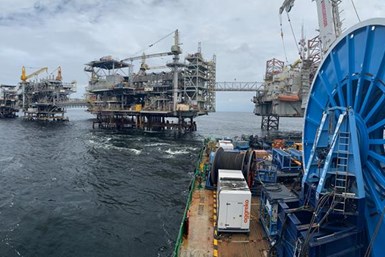Strohm and Petronas join forces to commercialize thermoplastic composite pipes
Strohm says the agreement will be instrumental in expanding knowledge of the design, production and qualification standards of its TCP products for the replacement of metallic pipes.

Photo Credit: Strohm, Petronas
Strohm (IJmuiden, Netherlands) a leading manufacturer of fully bonded, thermoplastic composite pipe (TCP), has signed an agreement with Petronas (Kuala Lumpur, Malaysia) technology commercialization arm, Petronas Technology Ventures Sdn Bhd (PTVSB) to commercialize TCP in the industry and scale up its across Petronas facilities. The partnership has ensured these products are available in the market with immediate effect.
The agreement will be instrumental in expanding the knowledge of the design, production and qualification standard from Strohm’s technology backbone, DNV (standard ST-F119), enabling operators to qualify and use TCP, instead of metallic pipes, creating substantial cost reduction potentials in all stages of oil and gas project life cycles.
Strohm and Petronas have been collaborating since 2012, when both companies embarked on a qualification program for TCP, followed by a successful pilot installation project for a full well stream production pipeline on the West Lutong field in Sarawak waters based in Malaysia.
With a growing global track record, TCP has become widely acknowledged for its many benefits compared to steel alternatives, including zero corrosion, reduced weight leading to improved transportation and installation costs and a lower carbon footprint.
For flowlines, Strohm says an added benefit is the reduction in pressure drops and improvement of multiphase flow conditions, thanks to a smooth bore, bonded pipe, immune to any gas permeation risks. For jumpers, a particular edge is the elimination of offshore metrology requirements, which can have a considerable impact on the cost and schedule risk associated with vessel standby and onshore rigid spool fabrication. A logical step forward from the single jumper application is Strohm’s “Jumper on Demand” concept whereby a long length of pipe is fabricated and stored on a single reel or cradle, ready to be cut and terminated in-country into individual jumpers as required.
“Another recent key development has been the confirmation that the glass fiber polyethylene material used for the Petronas pilot project is now complemented by carbon fiber polyamide and carbon fibre PVDF materials, which are fully qualified for full hydrocarbon well stream fluid applications,” Fabienne Ellington, Strohm’s vice president, Middle East and Asia-Pacific, says. “These materials are not susceptible to corrosion, blistering or embrittlement from CO2, H2S [hydrogen sulfide] or hydrogen, making them particularly suitable for highly sour service applications, carbon sequestration projects and hydrogen transportation. With these milestones achieved and the signing of the commercialization agreement with Petronas, our TCP solution is on track to further revolutionize the sector and support the energy transition.”
Dr Mahpuzah Abai, chief executive officer (CEO) of PTVSB says that Petronas believes innovation is key to unlocking a sustainable future. “Through our proprietary non-metallic pipe technology, we can provide an effective solution to corrosive and challenging operational environments. Having Strohm B.V. onboard will create a progressive partnership in this area,” Abai concludes.
Related Content
-
Plant tour: Albany Engineered Composites, Rochester, N.H., U.S.
Efficient, high-quality, well-controlled composites manufacturing at volume is the mantra for this 3D weaving specialist.
-
The potential for thermoplastic composite nacelles
Collins Aerospace draws on global team, decades of experience to demonstrate large, curved AFP and welded structures for the next generation of aircraft.
-
Combining multifunctional thermoplastic composites, additive manufacturing for next-gen airframe structures
The DOMMINIO project combines AFP with 3D printed gyroid cores, embedded SHM sensors and smart materials for induction-driven disassembly of parts at end of life.
















